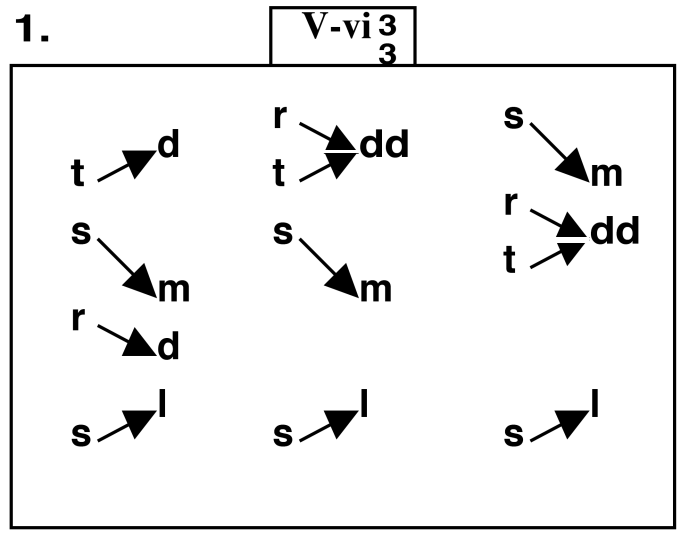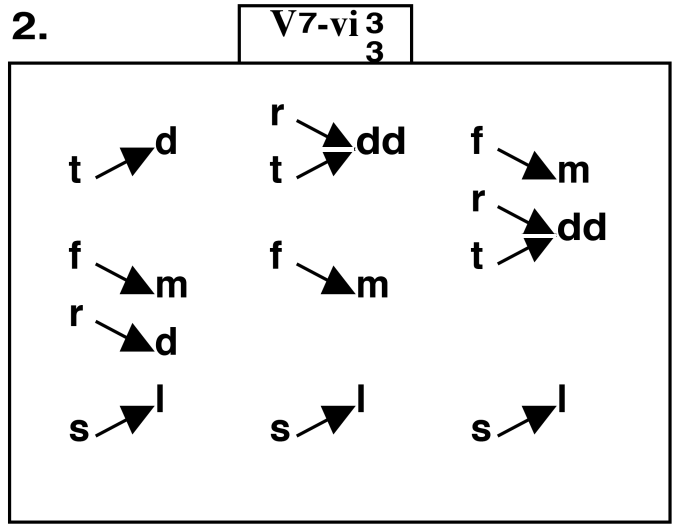11 Authentic, Half, Plagal, and Deceptive Cadences
Authentic, Half, and Plagal Cadences
A. Authentic cadence
The dominant to tonic resolution at the end of a phrase is an authentic cadence.
- If the soprano moves from re’ – do’ or ti – do’, it is a perfect authentic cadence (PAC).
- If the soprano ends on anything other than do, it is an imperfect authentic cadence (IAC). Possibilities for the soprano are r – m, f – m, s – s, or s – m.
B. Half cadence
If a phrase ends on the dominant triad V, it is a half cadence (HC). Due to its open-ended nature, the half cadence creates an expectation for a subsequent phrase or phrases, which conclude with an authentic cadence.
Typical approaches to the half cadence are IV(6) – V and ii(6) – V. The V chord can be prolonged by the [I ![]() ] – V formula.
] – V formula.
A half-cadence in harmonic minor between iv6 – V![]() is called a Phrygian cadence. The bass resolving a half step down suggests the final two notes of the descending Phrygian modal scale (fa – mi), thus providing the name. (See the chapter on modal music.)
is called a Phrygian cadence. The bass resolving a half step down suggests the final two notes of the descending Phrygian modal scale (fa – mi), thus providing the name. (See the chapter on modal music.)
C. Plagal cadence
If a phrase ends with the subdominant moving to the tonic, it is a plagal cadence (PC), also known as the “amen” cadence. The plagal cadence typically follows a PAC.
Deceptive Resolution – Deceptive Cadence
Deceptive resolution
The resolution of V – vi ![]() in major and V
in major and V![]() – VI
– VI ![]() in minor is a deceptive resolution.
in minor is a deceptive resolution.
1. In major keys, if the V(7) chord does not resolve to the tonic triad it may resolve to its substitute, the vi triad, in contrary motion.
2a. In harmonic minor, contrary motion is not possible due to the presence of the ti – le A2.
2b. To avoid the A2, ti – do and re – do resolve to a VI ![]() triad with doubled thirds do/do. The VI
triad with doubled thirds do/do. The VI ![]() chord, with its octave or unison doubled third, sounds “deceptively” similar to the tonic chord.
chord, with its octave or unison doubled third, sounds “deceptively” similar to the tonic chord.
2c. The deceptive resolution of V(7) – vi ![]() produces the same “deceptive” tonic-like effect in major keys.
produces the same “deceptive” tonic-like effect in major keys.
Deceptive cadence
3. When the deceptive resolution is employed to end a phrase, it qualifies as a deceptive cadence. The deceptive cadence is either V – vi ![]() or V7 – vi
or V7 – vi ![]() . The resolution of V – IV6 with ti – do in the soprano produces a somewhat similar deceptive effect.
. The resolution of V – IV6 with ti – do in the soprano produces a somewhat similar deceptive effect.
The deceptive resolution occurs within a phrase.
The deceptive cadence occurs at the end of a phrase.
Composers employ the deceptive cadence at the end of compositions to create an expectation for the final PAC or as a longer ending coda with a final PAC.
VOICE LEADING: Deceptive Resolution/Cadence
All progressions work in major and harmonic minor.
The similarly deceptive V – IV6 (iv6 in minor) is also shown above.
The similarly deceptive V7 – IV6 (iv6 in minor) is also shown above.
Other Uses of the Deceptive Resolution
The reverse of the deceptive resolution I – vi ![]() – V or I – IV6 – V produces an attractive soprano line (so – do’ – ti).
– V or I – IV6 – V produces an attractive soprano line (so – do’ – ti).
The vi ![]() and IV6 can appear consecutively to prolong the resolution to V: I – vi
and IV6 can appear consecutively to prolong the resolution to V: I – vi ![]() – IV6 – V, shown below in minor.
– IV6 – V, shown below in minor.
A less frequent deceptive resolution occurs in major, when the viio6 substitutes for the V(7) chord resolving to a vi ![]() with the doubled third (ti – do, re – do).
with the doubled third (ti – do, re – do).
Practice

